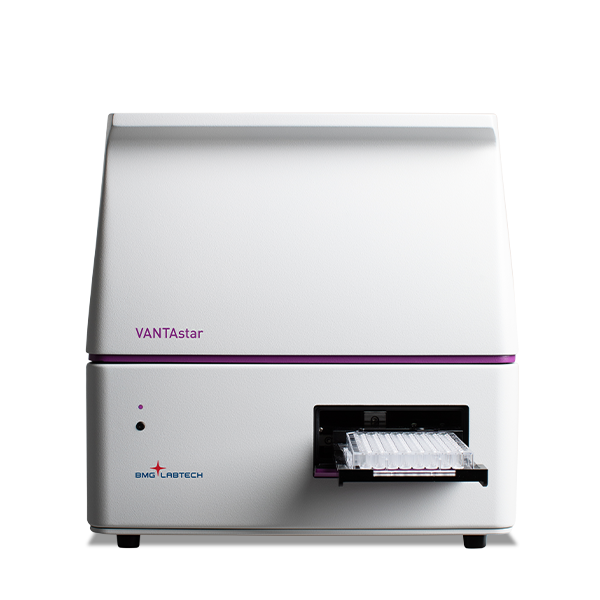In this interview, we speak to Martin Mangold, an applications specialist at BMG LABTECH, about their technologies and services, their new microplate reader VANTAstar, and the essential role microplate readers play within life sciences research.
Please can you introduce yourself and tell us about your role at BMG LABTECH?
Hi, my name is Martin Mangold, and I am part of the BMG LABTECH team at our headquarters in Germany, where I work as an Applications Specialist. Here, I use the knowledge and experience I gained from working with BMG LABTECH microplate readers during my doctoral studies in the field of pharmaceutical chemistry.
My position comprises many different tasks - I really enjoy the variety. I gather information on the latest trends and assays and make it available to our customers in the form of application notes, blogs, articles, webinars, and other means so that they can quickly get an overview of what's going on. Part of my work is also to practically implement and optimize emerging applications to support our customers in their research projects. Applicative customer support and troubleshooting is, of course, also part of this.
We are BMG LABTECH!
BMG LABTECH is a global developer and manufacturer of microplate reader instrumentation. Can you tell us more about why BMG LABTECH was founded and what some of your core aims and missions are?
BMG LABTECH was founded in 1989 in Germany with the aim to provide dedicated and specialized measurement platforms for life science researchers from industry and academia alike. In the more than 30 years since, we have continuously been developing unique and innovative technologies, defending our position as a technology leader in the field. We conceive, develop and produce all our readers in Germany.
Today, we remain the only independent manufacturer solely focused on microplate readers and are dedicated to offering readers of the highest quality to help scientists realize their full potential.
You have recently launched your new flexible microplate reader, the VANTAstar. Can you tell us more about this technology and how it works?
Gladly! The VANTAstar® was conceived for ease of use and flexibility to provide the perfect detection platform for a wide range of basic research and life sciences applications. Equipped with our patented LVF Monochromators™ for wavelength flexibility and the Enhanced Dynamic Range (EDR) technology for effortless detection setup, it is the ideal instrument for obtaining great data with ease.
Like all our microplate readers, the VANTAstar can be upgraded and equipped with a range of options and detection modes according to customer requirements.
VANTAstar Microplate Reader
Your VANTAstar product was designed for its ease of use and flexibility within basic research and life science. What are some of the benefits of the VANTAstar compared to other microplate readers available?
I can highlight a few. VANTAstar users do not have to worry about selecting the optimal sensitivity or gain settings - gain or focus adjustments are superfluous. The EDR technology grants a dynamic range spanning over eight concentration decades in a single measurement, ensuring almost any sample is always within range without user intervention, hence significantly simplifying the detection setup. This is specifically an excellent benefit for kinetic assays as there is almost no risk of running into detector saturation.
Combined with a rapid, full-plate auto-focus for both top and bottom reading in all plate formats, this feature makes detection easier, improving data quality. New users do not need to be trained to understand or adjust settings, while experienced users will easily get better data.
In addition, the reader is equipped with our patented LVF Monochromators that provide wavelength flexibility and filter-like performance and a cross-talk reduction package that automatically limits the negative effect of stray light and cross-talk in glow luminescence assays.
Your microplate readers can be used in a variety of research areas. Can you tell us more about some of the research areas that your products can be used in?
Due to their flexibility and the different available accessory options, our microplate readers can be used for a huge number of different applications in different research areas. Basically, everything that is not radioactive, produces a light signal and can be fitted in a plate format can be detected.
Typically, BMG LABTECH microplate readers are employed in life science research for applications ranging from cell biology, protein sciences, and metabolic studies to drug screening campaigns or diagnostic testing, just to name a few. We also have more "exotic" areas such as 0-gravity studies, synthetic biology, marine biology, and the food industry.

Image Credit: BMG LABTECH
As the only independent manufacturer focused solely on microplate readers, what advantages does this have for BMG LABTECH and your customers?
The most significant advantage for our customers is that we have been completely focusing on one instrument line from development to customer support for more than 30 years. Moreover, we are a middle-sized company where close personal contact is still valued and made possible. We appreciate that there are people behind plate readers. Support requests will never get stuck in a hotline. Queries are directly answered by our support specialists, either scientists, software developers, or engineers. From pre- to post-sales support, customer queries are personally discussed with the specialists who developed and manufactured the microplate reader or with us application specialists who know the ins and outs of preparing and performing microplate-based assays.
Moreover, we are independent from any kit or reagent provider. This ensures that we can provide customers with the best possible recommendations and suggestions for their biological questions.
On your site, you also offer a range of resources ranging from customer success stories to scientific talks and product videos. Why do you choose to provide such a wide variety of resources to your customers, and how does sharing these resources help build a relationship with your customers?
You know, we can tell people how good we are, but scientists trust their peers, wouldn't you? The best way to show our commitment is by showcasing the direct experience of our customers and how our readers and our support could help them progress their work.
This also includes application support. In our extensive online database, you can find over 200 application notes and 8,000 peer-reviewed scientific publications using BMG LABTECH microplate readers. Here, customers can find all the information they need to set up and optimize a vast range of assays and possibly suggestions for new assays. A lot of this material is produced in collaboration with our customers, and we are always eager to build and nurture these relationships.
Over the last decade, we have seen incredible advancements in life sciences, which could not have been possible without technology. How important do you believe technology is to the life sciences sector?
I believe technology and research are very important! The COVID-19 pandemic showed everybody the importance of rigorous and thoughtful scientific and technological progress. Novel technologies, such as CRISPR Cas9, which has revolutionized the study of genes and their functions as it allows very accurate and easy genome editing, help simplify the development of more complex assays to study specific scientific questions.
Measurement devices such as microplate readers need to be able to reflect these advances. Accordingly, we at BMG LABTECH strive to always be at the forefront of technology, offering the best technical solutions to scientists.

Image Credit: Gorodenkoff/Shutterstock.com
With continued technological advancements, what do you believe the future of life sciences research to look like? Are there any sectors that you are particularly excited to watch evolve?
Researchers keep focussing their attention on more complex questions and heterogeneous diseases. Accordingly, assays keep going more and more physiological to better reflect the complex conditions in the human body. I am excited to see which new advancements scientists come up with and am particularly interested in their possibilities for the study and treatment of diseases like Alzheimer's or cancer.
What’s next for BMG LABTECH? Are there any exciting upcoming projects that you are involved in?
We are always working on new technologies which can help scientists with their experiments and offer new and exciting possibilities for assay development. I can't tell you more now, but I am directly involved in several exciting projects that are currently in development and, I am sure, many scientists will really like! Keep an eye on our website and social media channels in the future!
Where can readers find more information?
You can find more information on our microplate readers on our website at BMG LABTECH - The Microplate Reader Company. Here, you can also find our extensive online database with application notes, blog articles, and publications highlighting various assay technologies and their performance on BMG LABTECH microplate readers. Feel also free to contact the applications team and me at [email protected].
About Martin Mangold
Martin Mangold works as an applications specialist at the BMG LABTECH headquarters located in Ortenberg, Germany.
Here, he is in frequent exchange with customers to address all their applications-based needs, from application support to the generation of scientific talks and other content such as application notes and scientific articles.